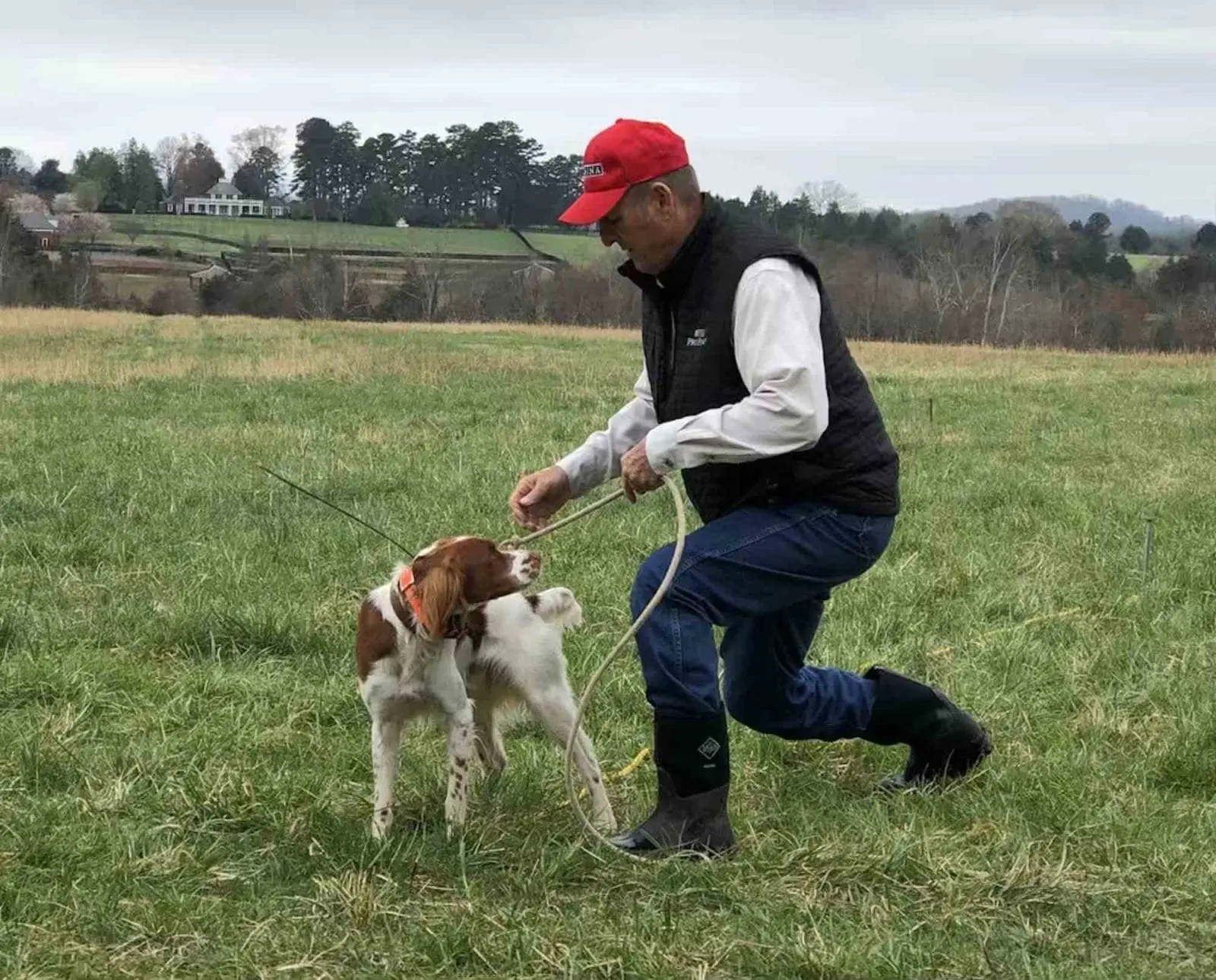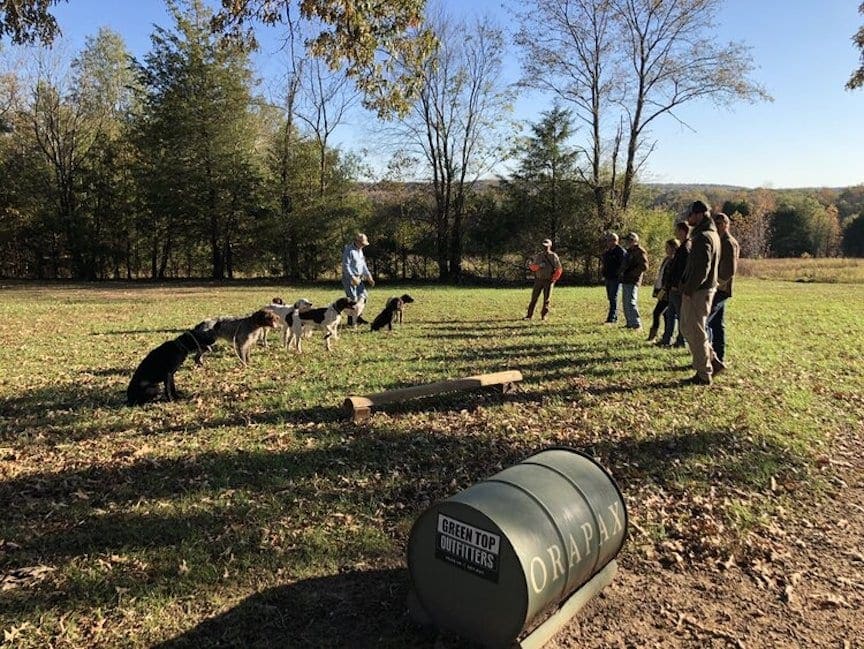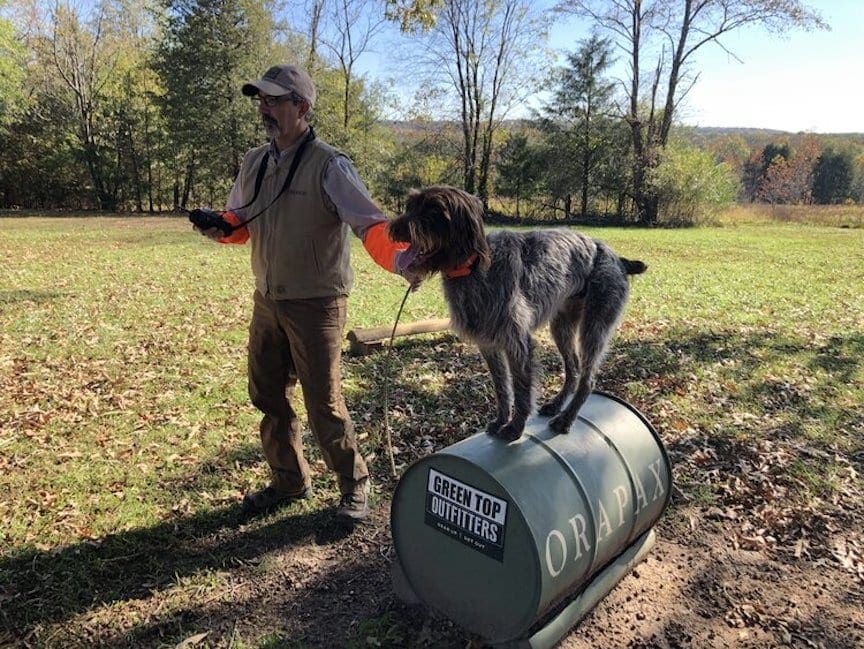Home » Hunting Dogs » The Smith Method of Bird Dog Training with Rick Smith
The Smith Method of Bird Dog Training with Rick Smith

Robb Moore has pursued the meaning of life from Tibetan…
DIY bird dog training using the Smith Method with trainer Rick Smith
This article is the second in a series intended to acquaint beginner bird dog trainers and handlers with the options available for DIY training systems and methods. The first article introduces and outlines the project here.
When experienced upland hunters and bird dog enthusiasts hear the name “Rick Smith,” they will immediately recognize him as one of the world’s most famous living bird dog trainers. Rick is a member of the Bird Dog Hall of Fame, the son of the legendary Delmar Smith (still active in his mid-90s), and the grandson of the legendary B.F. “Dutch” Epperson. Rick created the wildly popular Huntsmith Silent Command System of bird dog training along with his cousin Ronnie Smith. Rick and Ronnie both preside over their popular weekend Huntsmith Training seminars offered in foundation, intermediate, and advanced sessions, corresponding to the three stages of formal Smith bird dog training.
I had my first opportunity to meet Rick at a day-long obedience seminar for working dogs held a few years ago at my local training grounds in Virginia, where Rick attended as a special guest and sat for a no-holds-barred Q&A session over lunch with the day’s attendees. It’s easy to be in awe of Rick, a seasoned, down-home, charismatic cowboy sort of a guy, befitting his Oklahoma roots and his status as a scion of bird dog royalty. But despite how much I immediately liked Rick, I admit that I started that day with some prejudices about the Smith method that I’d picked up from others and which I’d bet at least some reading this harbor as well. As a newcomer, I wasn’t at all sure how I felt about some of the core Smith method techniques: the whoa post; the flank collar; and the strict, demanding obedience tasks and rigorous yard work upon which the system absolutely insists. Rick is the first to admit the Smith method isn’t for everyone (he will often say, with more than a slight grin, that it’s not for those who aren’t yet tired of the out-of-control behavior of their dogs). Put starkly, positive reinforcement/reward-based purists need not apply. But to hear Rick speak in-depth on the topic for the first time, it was impossible for me to resist the wisdom of his cousin Ronnie’s expression, “If you treat your dog like a human, your dog will treat you like a dog.” In other words, we have to give up some of our hang-ups to be the leader, trainer, and mentor that our dogs need us to be.
That first workshop introduction put me on the yellow brick road to Smith bird dog wizardry, for despite thinking I’d done a pretty good job training Lincoln to that point, it became immediately evident to me just how much I had to learn from Rick. While Lincoln sometimes—even often—obeyed me at heel and in some of the other routine tasks we had established in solo training, he wasn’t nearly as consistent as I imagined him to be nor was he immune to the distractions we encountered that day. Each of the participants was called up in front of the group to demonstrate whatever proficiency we had in heel work, on and off lead. I’m sure my complexion reddened a bit as my default pride turned to embarrassment with Lincoln pulling against his lead and ignoring my heel commands to jump and bark at the other dogs. But looking around at the general demonstration of other handlers’ mastery, exposed as merely a thin veneer over wanton canine disobedience, I also realized I had plenty of company in having a lot to learn.
My clearest memory of that day was being blown away by the transformation of a group of dogs on the tie-out cable when they weren’t allowed to demand attention through barking. This was accomplished by applying a Huntsmith Figure Eight to any dog who was throwing a fit on the chain gang. This behavior is an effort by the dog to demand our attention to let them free. It depletes the dog’s energy and causes anxiety in the other dogs who have learned to relax until it is their turn in the field.
This figure eight is a simple cord tied with a bowline knot at one end and a larger overhand knot to slide over a dog’s snout and mouth, secured by a slip knot that’s easy for a handler to release when the dog complies. It’s essentially a make-shift muzzle and in no way impedes the dog’s breathing or even drinking, though it should never be left on an unattended dog. This tool essentially takes away what is often the last hold-out of a dog’s resistance to any particular command: its mouth (barking, whining, etc.). Used early on in the training process on the tie-out cable, it can accelerate the process of a dog giving into the restriction of being put on the cable, with other dogs, until they quietly relax and await their handlers’ release into the yard for training or into the field to hunt. Rick explained the tool to us and had us apply them to our dogs whenever they started barking and whining.
Quickly, we witnessed a rowdy bunch of malcontents transform into calm and at-ease working dogs, patiently waiting for whatever interesting work project their handlers would supply next. Seeing that result, knowing I’d gritted my teeth for several months as my pup barked his head off whenever he was put on a chain waiting for his pass into the field, I was hooked and ready to learn more about the method.

Basic tenets of the Smith training approach
Manners, obedience, and yard work are foundational elements of the Smith system and are progressively woven into every stage of the system, from the moment a bird dog puppy is picked up at eight weeks through puppy development and into field work with birds. I think that’s what differentiates it most from other training philosophies, the most popular of which—to my eye—also seem very capable of getting a dedicated beginning trainer to achieve their field goals for their canine partners.
The Smith system’s foundational focus on yard work and rigorous manners are what captured my attention as the system that Lincoln and I most needed. It is ideally suited for people like me who have dogs as cherished family companions and pets first, who might live as I do in urban environments, but who also wish to fully engage their dogs in the demanding field pursuits for which hundreds of years of breeding and genetics have primed them and, by consequence, which these dogs undoubtedly most enjoy pursuing.
The intensive yard work and obedience tasks also allow a handler to achieve a foundational leadership position in relationship with their dogs outside of the bird field. This is important because intense corrections in the field are bound to result in the dog making detrimental associations between aversive stimuli and birds, giving rise to bird aversion, blinking, and other problematic behaviors. It has been helpful for me to think about the yard work as the opportunity to establish initial associations in getting Lincoln to stand still, go with, and come to (the boiled-down basics of all bird dog training), and to “take out the trash” in working through resistance behaviors. In return, by the time we are working lessons in the bird field, the lightest possible e-collar stimulation can be used to cue and not correct, to avoid problematic bird/correction associations.
Is the Smith training method good for beginners?
Speaking from personal experience as a beginner only a few years into the project of training my first bird dog, and from my assistance and/or witness of this method being employed with over a hundred handlers and dogs, I’d present the Smith system as one of the most beginner-friendly methods available. It’s a stair-step method, designed to offer safe harbor to a handler and dog by simply stepping back to previously-mastered steps in the process whenever new tasks are met with resistance. This gives the dog and handler a sufficient opportunity to both reinforce and shore up the handler’s leadership as well as digest the outlines of any new task. The Smith method is also one of the most fully-developed systems for beginners since there is a comprehensive set of resources available for introducing the key concepts and engaging in active, hands-on learning.
Beginners can start with the Huntsmith DVDs; the lessons introduced there can be extended considerably through Rick’s and Ronnie’s foundation, intermediate, and advanced seminars. Ronnie Smith, Susanna Love, and Reid Bryant also recently partnered to produce a comprehensive and stunningly beautiful history and guide to the Smith System: Training Bird Dogs with Ronnie Smith Kennels: Proven Techniques and an Upland Tradition. Some Smith method trainers are also starting to offer weekly dog training classes based on the method, which allows for continued hands-on work with beginners and their dogs, all the way up to and through advanced Smith method techniques. And for any who are looking for a window into the world of Smith dog training before the invention of the variable e-collars capable of cuing and not just correcting, I’d recommend that you get your hands on a copy of Best Way to Train Your Gun Dog: The Delmar Smith Method. While the methods detailed there are undoubtedly from a much earlier version of the system, it helped me to understand the Smith concepts and evolved e-collar applications, having now read about their analog predecessors.
For anyone cooling their heels with a new bird dog puppy waiting until the time is right to begin formal steadiness training (anywhere from seven months to over a year old), there are critical puppy development and initial bird and gun exposure tasks that are outlined well by the system for beginners and which prime the pup for later progress in the system. All of the above resources also offer a rich set of material for the handler to begin to internalize some of the method conceptually while their future hunting partner is still a pup and before attempting to implement its formal training components later with a young dog.

Takeaways from Rick Smith seminars
Prepped first by a complete viewing of the Huntsmith DVD material, my own understanding of the system really keyed off of Rick’s foundation seminar and many other intermediate and advanced seminar and workshop opportunities. For any who might have prejudices about the Smith whoa post and flank collar and the yard work that the system demands, I can assure you it’s really hard to argue with the striking and near-miraculous results that you witness with Rick (or Ronnie) and the dogs at the seminars.
Seminar participants get a chance to see specific and illuminating examples of leading dogs to do things they may want to do but need help doing, and more importantly, things they don’t initially want to do. Rick’s hands-on work with the dogs demonstrates that a handler who is willing to be the sort of fair and consistent, yet demanding, leader that dogs naturally want actually puts dogs at ease. While never abusive (Rick is very careful that handlers should always take care to avoid interacting with a dog out of anger or frustration), corrections and aversive techniques are sometimes required to break through a dog’s questioning of whether the human handler is a worthy leader of his or her pack.
Being the kind of leader that dogs are hard-wired to expect and accept allows them to immediately and visibly release the anxiety that can get in the way of their ability to learn. Rick teaches that when we fail to be the sort of leader our dogs need, they will always seek to fill that void with their resistance-as-leadership when they suspect it might be required: “Somebody has to be the leader here, and I’m not seeing it, so it must be me!” That this sort of dog-centric leadership demands our willingness to deliver quick and effective corrections is a very tough lesson for many of us to accept. But it’s one we might more easily intuit if we’re willing to do what Rick suggests by carefully observing dogs with one another, watching mothers teach their pups, and seeing littermates lead and correct each other. Such observation reveals that quick, dispassionate moments of correction spare all involved the protracted nagging and ongoing struggle for the clear leadership that dogs need to feel at ease and ready to learn.
Addendum: One handler/trainer’s grab bag of smith training method lessons
In sharing a home state with Rick and by assisting with training classes offered by professional trainer Neal Kauder, who counts Rick as his primary influence, I’ve been incredibly lucky to be exposed to and learn from both Rick and Neal on many more occasions than I deserve over the past few years. Here’s a distillation of some of the distinctive principles I’ve collected from these opportunities, reinforced by the training materials I’ve outlined above:
- For field success, we only have to teach our dogs three things: Go with us, come to us, and stand still. Every aspect of working bird dog training can be traced back to these three simple tasks.
- In formal training, firmly establish your leadership and deal with a dog’s resistance and behaviors in the obedience and yard work tasks so, by the time you hit the field and birds, you’re only using cue levels of pressure with the e-collar and are much less likely to create the sorts of thorny problems a heavy hand around birds is prone to create.
- Dogs aren’t native English speakers and if you pay attention, you’ll discover they never use it with each other. So keep your mouth shut and teach your dog through doing and manual corrections and cues. The overlay of the verbal command (if you insist on needing one at all) is the very last step, not the first.
- Whenever possible, help a dog progress through its natural resistance by helping the dog understand it can turn on or turn off pressure through its behavior.
- When you encounter a problem in the field and with birds, your dog either doesn’t understand what you are asking or your leadership in the yard and at home has faltered. Figure that out and go back to home or yard to address your leadership problems first.
- In all things, balance! Short training episodes with demanding tasks and/or tough new lessons always need to be balanced with activities the dog enjoys and finds less stressful to keep the dog (and the handler) loose.
Robb Moore has pursued the meaning of life from Tibetan Buddhist monasteries in the Kathmandu valley to the ivory towers of the academy, to Christian ritual as clergy, and hospital bedsides. Recruited as a bird hunter in his mid-40s by his spunky Brittany pup, Lincoln, he is still on the hunt, but only for birds, his heart having found its rest in walking meditation and the Tao of Bird Dogs. [More musings at amanandhisbirddog.com/blog]






I would find it interesting for you to compare and contrast what you took away from the Smith seminar vs the Lindley one. While a neophyte could easily assume they are miles apart they really are not. In fact I could make an argument that the Gibbons/West is a distillation of the Smith philosophy; dont treat the dog as a human but also try and think like a dog.
Mo does his “yard work” not in a yard but where a dog suspects there might be birds and adheres to the same tenets of come to me,go with me,and stand still but all within the framework of a predatory relationship,not blind obedience.
I honestly couldn’t agree more. First, I love that both emphasize silence from the handler and the handler learning to understand the world through a dog’s eyes, very much to your point. For me, it’s more “variations on a theme” and “differences in degree and not kind.” At the most superficial – maybe sometimes trivial – level, certainly some of the tools are slightly different (wonder lead v. pinch collar, carded pigeons v. launchers, types of launchers, exactly how they are used, type of check cord, etc.). If pressed to give a thumbnail of just a couple of the differences in degree to my sophomore eye, I’d say West/Gibbons/Lindley Steady w Style leans just a tick or two more gentle, does more of its formal steadiness work with the dogs in the bird field (with the birds as the primary teacher of steadiness) whereas Smith leans a little more heavily on the obedience tasks and yard work very much outside the bird field and the whoa post / flank collar to serve as foundational elements for that formal steadiness process. The handler is a just little more the teacher and little less the bird in Smith. Smith is a little more formulaic (and perhaps a bit easier to grasp for a green newbie) and a little more one-size-fits-all whereas West/Gibbons/Lindley Steady w Style emphasizes more the unique personality / disposition of the individual dogs and improvisation and adaptability in the handler. Those are just a few and I need to emphasize those are differences I see in degree only and the systems are indeed much more alike than different in my mind. I also don’t view either system as “superior” over the other and there is so much to admire about each both in ways they are similar and the ways they are distinctive. But I do see each, with their distinctive emphases, as a better fit perhaps for some handlers and some dogs and some situations. But for me, in the end, I’d say something similar about these two great training systems as I might observe about religions: while the disciples, theologians, and zealots from the different traditions will get all lathered up to argue with and debate their adversaries, bring the true masters and mystics from those same traditions together and they are apt to spend a lot more time in smiling agreement.
I often wonder if any of the discipline oriented trainers have ever encountered HIggin’s Method – here’s the introduction: https://higginsgundogs.com/about-us/our-method/
Unlike other methods of training that are based on obedience, repetition and pressure, we encourage cooperation through success. Dogs we train teach themselves to be steady. It’s natural, it’s how their brain is wired. They are born with the ability to do it.
Don’t get me wrong, dogs aren’t cooperative merely for the sake of others. Predators don’t think that way. They will simply do what it takes to be successful. If it takes being part of the pack or working with me to get the bird, so be it. They will cooperate and give me everything they have, every time.
Using our method based on dog psychology, we are able to get the dogs to show us their understanding of stop to flush, steady to wing, steady to shot, steady to kill and honoring a dog on point with no pressure (no verbal commands or electric collar). We are able to do this because we show them success first. We don’t start with obedience or yard work . We start with birds. The birds teach the dogs. If the dog gets pushy, the bird leaves and the dog looses. With our method, the dogs learn what works (being steady) and they are given the opportunity to learn what does not (flushing or chasing birds).
My Brittany Sam is just shy of 2 years old. Is he too old to start any field training?